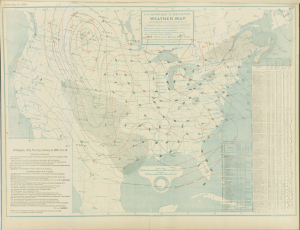It is almost winter. Almost every winter, an Arctic blasts comes and gives us cold weather. Well, almost. Some winters do not get that cold, like after the December 1989 freeze, where there was no freezing temperature for the rest of the winter in Southeast Texas. All freezes in Texas are cold. However, not all freezes are the same. Some Arctic freezes are prolonged, while others are not. Some are deep, while others are shallow in terms of layer of cold air. Deep freezes usually give Houston snow, while shallow freezes give sleet and ice storms.
The freezes I will be looking at are January 1948, January-February 1951, January 1982, December 1983, February 1989, December 1989, February 1996, January 1997, and January 2010. The 1951 and February 1989 freeze were prolonged freeze for Southeast Texas. The reason I chose them are they were either hard and/or prolonged freeze. Not all the freezes produced snow or ice storms. The 1951 freeze had Houston below freezing for days and is a record to this very day. Also, there was a massive ice storm and a few snowfall in the 1951 freeze. The December 1989 freeze was a deep freeze on the level of December 1983 and possibly Feburary 1895 and 1899.
Here are anomaly maps of the freeze from surface to high up. They are 1000, 850, 500, and 300 millibar. I got the maps from Here is explanation of Daily Mean Compositesheight chart maps at 1000, 850, 500, and 300 millibar height and their altitude equivalent.
January 1948
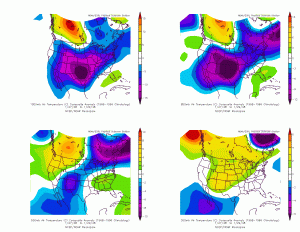
It is cold at the 1000 and 850 millibar level. It is normal temperature at the 500 and 300 millibar level.
January-February 1951
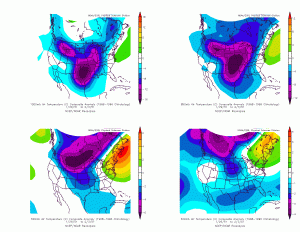
The most prolonged freeze in Southeast Texas to this very day. It is unusually cold at all levels. Despite the cold air mass being a deep one, Southeast Texas saw mostly ice storms and only a few snow flurries out of it.
January 1982
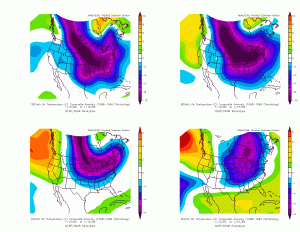
A hard freeze that was cold up to the 850 millibar level. It was warm at the 300 millibar level. The 1982 freeze and even had some snowfall and a low of 12°F in Houston!
December 1983

The December 1983 freeze was a major freeze. It was responsible for the coldest Christmas on record in Southeast Texas. It was cold at the 1000 and 850 millibar level. Interestingly, it was warm at the 500 and 300 millibar level. This is despite the fact that Central Texas saw snow during the December 1983 freeze.
February 1989

The second most prolonged freeze in Southeast Texas besides 1951. It occurred in a strong La Nina. It also produced ice storms mixed with snow flurries. It is bitterly cold at the 1000 millibar level. It is seasonal normal at 850 millibars. It is unusually warm at the 500 and 300 millibar level. The February 1989 freeze was a shallow freeze.
December 1989
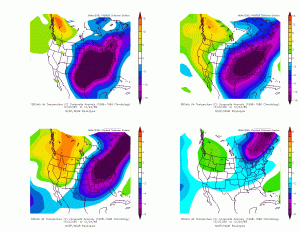
The second big freeze in 1989. It was the biggest freeze since December 1983 freeze. There was snowfall in Southeast Texas and single digit temperatures, which set records throughout the area. The freeze was cold from 1000 to 300 millibar level. This freeze was the last time Southeast Texas saw single digit temperature. If you take the law of average that happens about every 30 years! Upper Texas Coast has a better chance of getting hit by a major hurricane than seeing single digit temperature! A major hurricane hits Upper Texas Coast about every 10 years on average. The probability of seeing two back to back single digit temperatures would happen every 900 years! Compare that to seeing two major hurricanes making landfall on the Upper Texas Coast, every 100 years. There are no records of two major hurricanes hitting the Upper Texas Coast in one season. However, sometimes storms get upgraded in the Atlantic Hurricane Reanalysis, so it could be possible that Texas has been hit by two major hurricanes in one season.
February 1996
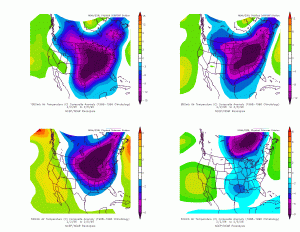
The last big freeze that had Houston plunging below 25°F until 2010. There ice storms that shut down the city. This freeze was a very deep freeze, cold from surface to atmosphere.
January 1997
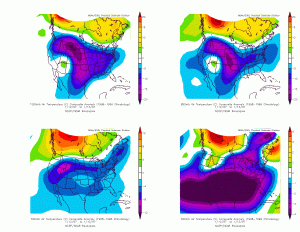
The cold front that brought on the freeze was not eventful. However, as the front progressed over the Gulf of Mexico, a low pressure system formed and moisture returned in the form of an ice storm. There was even thunder in those ice storms.
January 2010

The big freeze for the unusually cold winter of 2009-2010. No snowfall or ice storm, just plain cold. It was the coldest since February 1996 freeze. It was unusually cold at all levels. Now, had there been a low pressure system over the area of cold air, we could of seen a nice snowstorm.
There are two freezes I would like to see the anomaly map of, February 1895 and February 1899 freeze, but data is limited, just to surface weather and pressure maps. I would be most interested to know how deep 1886, 1895, and 1899 freeze were. I would have to guess they were a deep freeze since both produced snow. The 1899 freeze is unique that the whole nation was freezing, which is very unusual because if there is freezing weather, other parts are mild. Also in 1899, Houston saw back to back single digit temperatures, which is a rarity. There were only four reports of single digit temperatures officially in Houston going back to 1895, they were in 1899, 1930, and 1989.
Just for kicks, here are weather maps from 1895 and 1899. They are from NOAA Central Library U.S. Daily Weather Maps Project. They are older than your grandparents!
Notice that there is a large and strong high pressure system over Montana in both 1895 and 1899 freeze and they are in the month of February. They almost look like carbon copies of each other.
Here is some things I notice after those huge freezes:
-After the January 1886 freeze, Texas would be hit by four hurricanes, in which three made landfall. One of them was the Indianola Hurricane, which destroyed Indianola and people abandoned it for good. Prior to that hurricane, Indianola was a flourishing port city. It was rebuilt after another major hurricane hit in 1875.
-A year after the 1899 freeze, the Great Galveston Hurricane of 1900, hit Galveston and killed 12,000 people. Ironically, Galveston grew in part because Indianola was abandoned. To this very day, it remains the deadliest American disaster. It exceeds the death toll of 1906 San Francisco Earthquake, September 11, 2001 Terrorist Attacks, and Hurricane Katrina.
-After the December 1989 freeze, it was a mild winter. No freezing temperatures for the rest of the 1989-1990 winter! Same applied to February 1895 and 1899 freeze, it got warm afterwards.
What do these freezes show? Not all freezes are the same. When Texas is cold, another part of America is warm. Also, many of these freezes come from the west. Also, some freezes are cold spells, while other produce ice storms and even blizzards!

